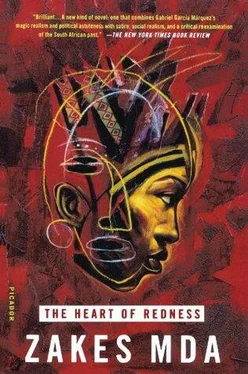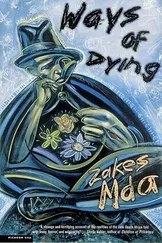“Sir George Grey had no intentions of attacking the amaXhosa,” explained Dalton. “He merely wanted to scare the Believers with HMS Geyser . The ship was on its regular route from Natal to the Cape Colony. Sir George decided that it should make a call at the Kei mouth to demonstrate the British naval power.”
No one believed Dalton.
When he had left, Twin-Twin said, “They would make excuses for their spectacular defeat at the hands of the Believers, wouldn’t they?”
What worried Twin-Twin most was that as a result of this so-called demonstration of the queen’s sea power the Believers were becoming even more arrogant. They were once again going around attacking Unbelievers. And The Man Who Named Ten Rivers was refusing to give the victims of these attacks any assistance. When his representatives in the region, people like Gawler and other magistrates, sent urgent messages that the Unbelievers should be assisted, he responded that the British government could not send parties throughout what he called Kaffirland to defend each person who might be attacked.
“In any case,” he added, “if we were to do that, we would be playing right into the hands of Kreli and Moshesh, who are plotting a war against the colony. That would give these diabolical chiefs an excuse to attack.”
The only thing that could be done was to ask the unbelieving chiefs to give refuge to the seeing Unbelievers and to ensure that they were not harmed. There was nothing else that could be done, unless the problems spread to the lands that were set apart for white occupation.
This attitude reinforced Twin-Twin’s view that The Man Who Named Ten Rivers had planned the whole cattle-killing movement. And that he had cleverly invented these prophecies and used Nongqawuse, Mhlakaza, and Nombanda to propagate them among the amaXhosa people. He wanted the amaXhosa to destroy themselves with their own hands, saving the colonial government from dirtying its hands with endless wars. This view was gaining currency among those Unbelievers who were not Christians.
“The Strangers that Nongqawuse saw,” explained Twin-Twin, “were The Man Who Named Ten Rivers himself, maybe with Gawler and Dalton.”
Those Unbelievers who were Christians, such as Ned and Mjuza, did not agree with this view. They echoed The Man Who Named Ten Rivers’ view that Nongqawuse’s visions were nothing more than a plot by Sarhili and his friend, Moshoeshoe of the Basotho nation, to starve the amaXhosa into rebellion against the British Empire.

The Believers couldn’t be bothered with these debates. They had debates of their own. A new prophetess had arisen at the banks of the Mpongo River. She was Nonkosi; the eleven-year-old daughter of a well-known traditional doctor called Kulwana.
Nonkosi’s visions began early in January. She saw Strangers who were similar to those seen by the great prophetesses of the Gxarha River. They first emerged to her when she was playing near a pool in the Mpongo River. They showed her a great number of cattle in the water and the new people that would rise if the amaXhosa destroyed all their cattle. They told her of various peoples who were going to be destroyed for not believing, and these included the Basotho, the amaMfengu, and of course the English, who would run to Kingwilliamstown and be destroyed there.
The strange thing about the daughter of Kulwana was that she did not look confused and unkempt in the manner of great prophets. She was not waifish and malnourished. She was zestful and liked to spend the whole day playing children’s games instead of sitting with the gray-beards teaching them about the happy times that were coming with the new people from the world of the ancestors. But when she was called to order, her message was clear and resounding. It came out of her little mouth in musical peals. It made grown men cry with joy.
Although Nonkosi’s message was similar to Nongqawuse’s, she gained a new following. Among the young Believers it became fashionable to identify oneself as Nonkosi’s follower rather than Nongqawuse’s. Whereas Nongqawuse urged her followers to wear ornaments and makeup, Nonkosi’s teachings were that ornaments should be disposed of. She further gave instructions that fires for cooking or for any other purpose should be made only of sneezewood, instead of the more popular mimosa.
Kulwana became his daughter’s staunchest supporter. He told her followers that he too had heard the cattle lowing and bellowing from the pool.
It seemed that there was competition between the two prophets. In reality the competition was between their followers. The prophets spoke with one voice and did not see each other as rivals. All they wanted was to save the amaXhosa nation.
Twin and Qukezwa were curious about the new prophet. They undertook a two-day journey to visit her at the Mpongo River banks. It was an arduous trip, for Heitsi slowed them down considerably. But they did not regret it one bit. They were energized by Nonkosi, and were filled with new hope. She led them, together with hundreds of other followers, to a pond near the river, and there they saw newly circumcised abakhwetha initiates dancing on the surface of the water. They joined in the song and danced, albeit on solid ground. They saw the horns of cattle emerging from the water, then sinking again, and heard the lowing of cows and the bellowing of bulls. In the evenings they participated in the ukurhuda rituals where the wonderful prophetess administered sacred enemas and emetics to her followers. They vomited and their stomachs ran all night long.
Like all of Nonkosi’s followers, Twin and Qukezwa shaved off their eyebrows in order to distinguish themselves from Unbelievers.
Although two denominations of Believers had emerged, Twin and Qukezwa decided that they would follow both prophets. When they returned to the Gxarha they introduced the fashion of shaving off the eyebrows. The Believers there happily adopted it, even though it was Nonkosi’s invention.
Using the herbs they had brought with them from the Mpongo River, Qukezwa and Twin frequently indulged themselves with revelries of vomiting and purging.
The problems of redness!
Camagu is facing the irritation of Xoliswa Ximiya. And this threatens to put a damper on his housewarming party. She does not seem to care at all that she is a guest in his house. Guests, like hosts, are generally expected to be gracious. That is why the other guests — the elite of Qolorha-by-Sea such as John Dalton, the teachers of the various schools in the area, and Vathiswa, the receptionist at the Blue Flamingo Hotel — are fidgeting on their seats. Some of them may agree with Xoliswa Ximiya’s point of view, but they do not think that it is right to attack a man at his own housewarming party. And Camagu seems determined to stand his ground.
“I say it is an insult to the people of Qolorha-by-Sea,” Xoliswa Ximiya screeches. “My people are trying to move away from redness, but you are doing your damnedest to drag them back.”
“To you, Xoliswa, the isikhakha skirt represents backwardness,” says Camagu defensively. “But to other people it represents a beautiful artistic cultural heritage.”
Camagu is the only one in the village who calls Xoliswa Ximiya just by her first name — besides her parents, of course. This is one of the things that have fueled rumors that something is cooking between them. This, and the fact that they argue all the time. And then there are the visits to her house in the schoolyard, which sometimes take place in the evening. Others believe that he has slept there on occasion, although no one can vouch to have seen him with their own eyes.
“Even in magazines people wear isikhakha,” says Vathiswa. Although she is known as Xoliswa Ximiya’s lackey, she feels that this time, in the presence of all these honorable guests, she must contribute her little piece of wisdom as honestly as she can. But Xoliswa Ximiya’s glaring eyes silently reprimand her for her treachery.
Читать дальше













